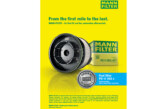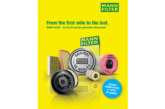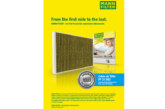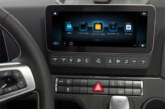Braking systems remain one of the top causes of failures at annual test. To help operators better prepare their vehicles and understand the test, the DVSA offers a guide to passing the brake test, complete with best practice advice.
Locked wheels and the brake test
The DVSA insists that vehicles must be fully loaded at test, because the grip between the tyre and the RBT rollers is more effective that way. The wheels keep turning for longer and a higher brake force will be achieved.
If the vehicle is empty or only lightly loaded, the grip between tyre and the road (or the rollers on a roller-brake tester or RBT) will be lower, and a relatively small brake force will cause the wheels to lock and stop turning. Once locked, no matter how much more the brakes are applied, the recorded brake force won’t increase. This means that if the vehicle’s load is too light, the wheels may lock before achieving the required brake efficiency. On unladen vehicles, this will result in a test failure.
“The DVSA insists that vehicles must be fully loaded at test, because the grip between the tyre and the RBT rollers is more effective that way.”
Testers can also pass a vehicle on locks, provided more than half the wheels on a system lock on front wheel lock allowance (FWA), which takes into account the weight transfer to the front axle(s), but only if the vehicle is laden. The DVSA warns, however, that operators should not rely on these two concessions when preparing vehicles for a brake test.
Brake test check list
1. Load the vehicle.
2. Have all the brakes had time to bed in?
3. Do you know the correct method of inspection?
4. Avoid steam cleaning. Steam- cleaning the vehicle brake system immediately before test is highly likely to reduce the brake performance.
5. Is the RBT calibrated and in good condition?
6. Has the vehicle exceeded the minimum efficiency required in the manual?
7. It shouldn’t be necessary to alter the Load-Sensing Valve (LSV) settings outside of the manufacturer’s pre- set limit to achieve a satisfactory brake result. Altering the LSV settings can lead to over-braking of the rear wheels, which is a potential road safety hazard.
8. Secondary braking systems – vehicles are fitted with a secondary brake, typically either through a split braking system, or a progressively applied hand control valve. Make sure you know which type your vehicle has, and if the other system can be used as an alternative.
How to prepare for the brake test
Loading
ATFs will check vehicles are loaded to 65% of design axle weight. Load simulators are permitted and some ATFs may have a ballasted trailer available for hire. Where load simulators can’t be used, vehicles or trailers – unless exempt by design – must be loaded when tested. Tractors must be coupled to a loaded semi-trailer, so that the drive axle is loaded at or very close to the plated weight shown in column two of the plate and plating certificate.
When loading a vehicle for brake test, the DVSA advises:
■ Place loads close to the rear axles.
■ Aim to apply at least 65% of the design axle weight to each axle (not less than 50%).
■ Use similar loads to add weight to the vehicle – this will help by placing the loads correctly, and achieving consistency between tests.
Pre-test brake performance checks
With an RBT:
- Ensure the rollers are clean, in good condition and well gritted, and the RBT is calibrated.
- Present the vehicle loaded to at least 65% of design axle weight.
- If you have a computerised RBT, ensure it has the current version of the DVSA’s DTp (now DfT) number database installed in your machine so that new vehicles are recognised.
- If you have a manual RBT, decide what the vehicle’s braking needs are to help calculate brake performance.
- Decelorometer testing is available at a limited number of ATFs, but only permitted if an RBT is not possible.
Without an RBT
Local franchised dealers, vehicle repairers and local authorities may offer RBT brake check services. Ensure brake performance is included in routine maintenance.
Changes in May
With some changes made on 20th May this year, Gordon Thomson, Head of Vehicle Testing Policy at DVSA, has commented on the results. “The data on the new test suggests that, with the exception of emissions, there’s been little impact on test failure rates. This is in line with what we’d expected. It’s resulted in emissions entering the top 10 defects for both HGVs and PSVs and accounts for around 1% of test failures. The increase in the emissions fail rate has happened because we’ve added several new or amended elements to this area of testing.” These include:
■ Using manufacturers’ plate limits for smoke testing
■ Using a stricter default limit for Euro 6 vehicles
■ Checking for smoke coming from a DPF- equipped vehicle
■ Checking if emissions control equipment is missing, modified or showing signs of tampering
■ Checking if the engine MIL is operating correctly
“We’ll continue to identify trends on test failures and prohibition issues over the next few months.”
Vehicles no longer exempt
Some heavy vehicles (based on a heavy goods vehicle (HGV) chassis) stopped being exempt from needing an annual test on 20th May 2018. For some of these vehicles, you have up until the date your vehicle tax renewal is due to get it tested for the first time. This is known as the ‘phased approach’. However, other vehicles need to have an annual test certificate from 20th May 2018.
These categories of vehicles stopped being exempt from annual tests on 20th May 2018:
- mobile cranes
- breakdown vehicles
- engineering plant and other plant, which is movable plant or equipment being a motor vehicle or trailer (not constructed primarily to carry a load), especially designed and constructed for the special purposes of engineering operations
- trailers, being drying or mixing plant, designed for the production of asphalt or of bituminous or tarmacadam
- tower wagons
- road construction vehicles (but not road rollers and other specialised equipment not based on an HGV chassis)
- electrically propelled motor vehicles first registered since 1st March 2015
- tractor units pulling exempt trailers
- motor tractors and heavy and light locomotives exempted under sections 185 and 186 (3) of the Road Traffic Act 1988, where these are










